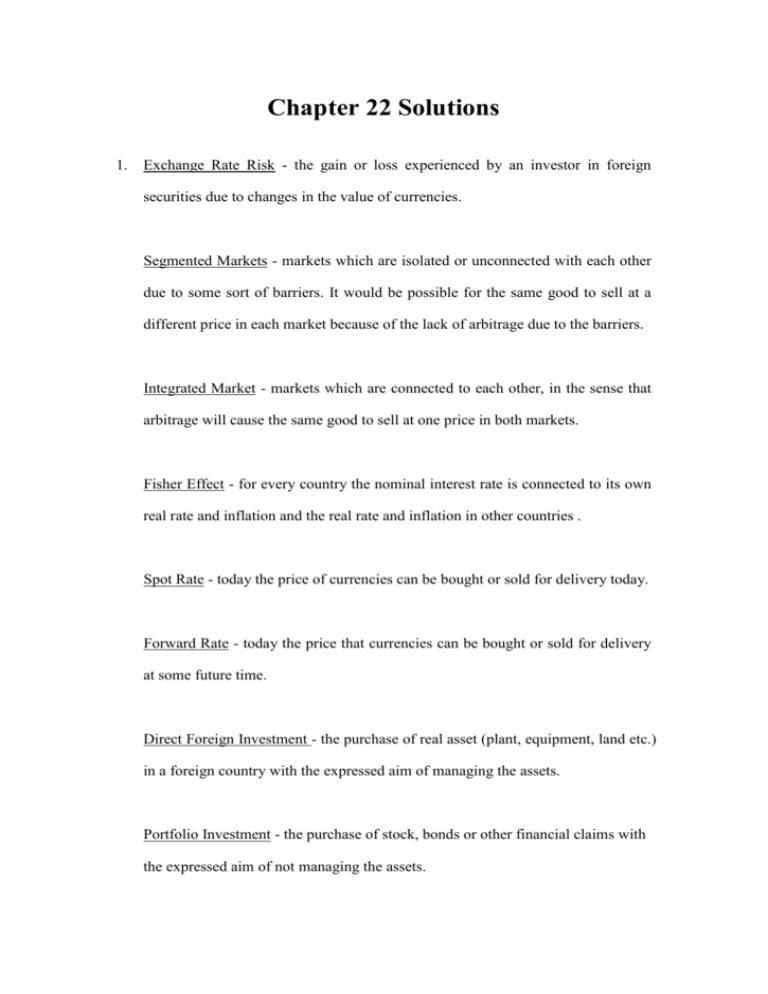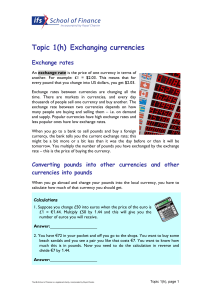Chapter 22 Solutions
advertisement

Chapter 22 Solutions 1. Exchange Rate Risk - the gain or loss experienced by an investor in foreign securities due to changes in the value of currencies. Segmented Markets - markets which are isolated or unconnected with each other due to some sort of barriers. It would be possible for the same good to sell at a different price in each market because of the lack of arbitrage due to the barriers. Integrated Market - markets which are connected to each other, in the sense that arbitrage will cause the same good to sell at one price in both markets. Fisher Effect - for every country the nominal interest rate is connected to its own real rate and inflation and the real rate and inflation in other countries . Spot Rate - today the price of currencies can be bought or sold for delivery today. Forward Rate - today the price that currencies can be bought or sold for delivery at some future time. Direct Foreign Investment - the purchase of real asset (plant, equipment, land etc.) in a foreign country with the expressed aim of managing the assets. Portfolio Investment - the purchase of stock, bonds or other financial claims with the expressed aim of not managing the assets. ADR - American Depository Receipt, A financial claim issued in the U.S. which represents the ownership of stock in a foreign country. 2. Total Return = (degree of return) (change in exchange rate) A. 14.24% = (1 + .12)(1.02) − 1 B. 4.5% = (1 + .10) ( 1 − . 05) − 1 C. 7% = (1 + .07)(1 + 0) − 1 D. −12% = (l. + .1) (1 − .2) − 1 3. Some but not all of the currency risk can be diversified away for the U.S. investor. The dollar being the world standard to which most other currencies are compared makes it difficult for the U.S. investor to totally eliminate risk. Currency variations consist of two components; random fluctuations of all currencies with each other and equal fluctuations of all non-dollar currencies with the dollar. For the U.S, investor, the first risk can be diversified completely, the second risk can only be modified by adjusting the total portion of the investors portfolio into non-dollar assets. 4. R International Domestic risk This relationship exists because: 1. the returns internationally are higher than domestically 2. the correlations between securities are lower internationally. 5. Segmented markets exist because of barriers. Barriers such as: legal restrictions; transaction costs; lack of information; unfamiliarity with foreign markets; currency risks, and controls; political risks; government rules and regulation for foreign investors etc. 6. The country with the higher rate of inflation will eventually have to devalue its currency in order for the Purchasing Power Parity Theory to hold. The degree of devaluation depends on the amount of trade between countries, the governments monetary policy, relative interest rates between countries, and government intervention in the foreign exchange markets. 7. E S1d f S S0d E S1d f f 61ff 1 6 ff E S1d f d f 0 E(I d ) E(I f ) 1 E(I d ) .05 .10 1.05 1 6 ff $1 6 ff (.05 1.05) $1 6 ff $.047619 6 ff .166 .0079365 E S1d f $.1587301 ff 6.30 ff $ 8. The evidence of the efficiency of world capital markets is mixed. What is needed is a simultaneous evaluation of financial markets, currency markets, and real markets. 9. ADR's are financial instruments issued by American banks against shares deposited with the banks overseas brinks of a custodian, ADR's allow U.S, investors to buy and sell foreign securities. The return of ADR's is denominated in dollars and also reflects the movement of exchange rates as well as security price movements. They avoid foreign taxes, provide dividend collection services, avoid foreign regulation against foreigners and home liquidity. 10. A Eurobond is a long term debt instrument issued by a corporation of one rationality to an investor of a different rationality in an unregulated market, denominated in a currency which is different from the currency of the country of the issuing company. Advantages: 1. low risk, 2. higher yields on a risk adjusted basis then comparable U.S. bonds ,and 3. no taxes. 11. The valuation model for the European type of currency call option can be defined as C Se rf t N (d1 ) Xert N (d2 ) , Where S = spot exchange rate, r = domestic risk-free rate, rf = foreign risk free rate, X = exercise price, σ = standard deviation of spot S ln X exchange rate, t = time to expiration, d1 2 t r rf t 2 , t S ln X and d 2 2 t r rf t 2 d1 t . t S=80, X=85, r=3%, rf =2%, σ =15%, t=1 (0.15) 80 ln 0.03 0.02 85 2 d1 0.2625 0.15 2 d 2 d1 t 0.2625 0.15 0.4125 The value of the currency call option on the Japanese yen is N (d1 ) N (0.2625) 0.3965, N (d 2 ) N (0.4125) 0.3400 C 80e0.02 (0.3965) 85e0.03 (0.3400) 3.0446 12. The European style of index call options can be evaluated as C S N (d1 ) Xe rt N (d 2 ) , where S Se qt , S = spot exchange rate, q = dividend yield per year, r = risk-free rate, X = exercise price, σ = standard deviation of spot exchange rate, t = time to 1 expiration, d1 [ln( S X ) (r q 2 )t ] t , and d2 d1 t . 2 S=1000, X=950, r= 6%,σ =15%, t=3/12=0.25, Total dividend yield during 3 months is 1%, so dividend yield per annum is 4% (that is, q =4%). 1 d1 [ln(1000 950) (0.06 0.04 (0.15)2 )(0.25)] (0.15) 0.25 0.7881 2 d 2 d1 t 0.7881 (0.15) 0.25 0.7131 N (d1 ) N (0.7881) 0.7847, N (d 2 ) N (0.7131) 0.7621 C 1000e0.04(0.25) (0.7847) 950e0.06(0.25) (0.7621) 63.6495 13. The rate of return on ABC in terms of Japanese Yen is [(250+20)-200]/200=0.35 or 35%. The rate of return in terms of U.S. dollar is 100(250 20) 1 0.5 or 50% 90(200)








